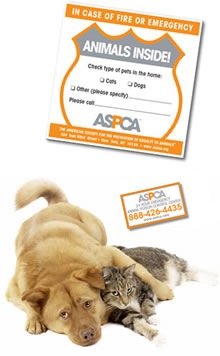Learn How to Prevent Pet-Related Fires in Your Home
Pet Fire Safety & Fire Prevention Tips
The National Fire Protection Association estimates that nearly 1,000 home fires each year are accidentally started by the homeowners’ pets.
By following the tips below, you can prevent a pet-related fire in your home:
- Extinguish open flames – Pets are generally curious and will investigate cooking appliances, candles, or even a fire in your fireplace. Ensure your pet is not left unattended around an open flame and make sure to thoroughly extinguish any open flame before leaving your home or going to bed.
- Remove stove knobs – Be sure to remove stove knobs or protect them with covers before leaving the house – a stove or cook top is the number one piece of equipment involved in your pet starting a fire.
- Invest in flameless candles – These candles contain a light bulb rather than an open flame, and take the danger out of your pet knocking over a candle. Cats are notorious for starting fires when their tails turn over lit candles.
- Secure young pets – Keep them confined away from potential fire-starting hazards and electrical cords when you are away from home such as in crates or behind baby gates in secure areas.
- Inspect and pet proof – Be aware of loose electrical wires, small appliances, and other hazards within your pet’s reach. Try to use electrical products that will automatically shut off, when able.
- Consider upgrading your fire alarm system – Battery operated smoke alarms will not only scare your pet but won’t alert anyone to a fire if you are not there. Monitored smoke detectors alert a monitoring system that can then alert both you and the nearest fire station to a fire in the home.
- Do a weekly check of electrical pet equipment – If you own fish, reptiles, or other critters that rely on heating, filtration or lighting systems, ensure that you inspect all wires and equipment at least once a week and dispose of or repair any equipment or wiring that is damaged or faulty.
 Help Firefighters Help Your Pets
Help Firefighters Help Your Pets
- Keep pets near entrances when away from home – Keep collars on pets and leashes at the ready in case firefighters need to rescue your pet. When leaving pets home alone, keep them in areas or rooms near entrances where firefighters can easily find them.
- Use pet alert window clings – Write down the number of pets inside your house and attach the static cling to a front window, near the front door, and the same for a backdoor or window. This life-saving information saves rescuers time when locating your pets. Make sure to keep the number of pets listed on them updated. (Get a FREE Pet Safety Pack of window clings from the ASPCA)
Home fires are the most common disaster that the American Red Cross responds to – and also the most preventable. According to the United States Fire Administration, an estimated 500,000 pets are affected annually by fires.
Download this free, printable Fire Prevention & Safety Checklist (pdf) from the Red Cross, to help you protect your family, pets, and home from fire hazards.
Additional info: Helpful Disaster Safety Tips for Pet Owners
Have a People & Pet Disaster Preparedness Plan Ready!
The best way to protect your pets from the effects of a fire is to include them in your family plan. This includes having a pet-ready disaster supply kit as well as arranging in advance for a safe place for them to stay if you need to leave your home. In the event of a disaster, if you must evacuate, the most important thing you can do to protect your pets is to evacuate them, too.
Resources for this article: Pet Fire Safety – American Red Cross

 Help Firefighters Help Your Pets
Help Firefighters Help Your Pets